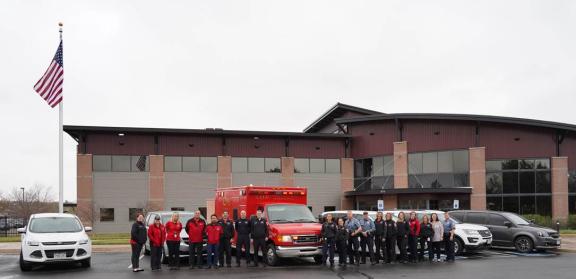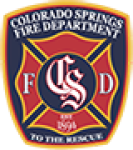

Caring for our community
The Community and Public Health Division encompasses mobile response teams such as CRT and multiple navigational programs that operate under the CARES umbrella.
About Our Division
The Community and Public Health Division (CPH) of the Colorado Springs Fire Department was formed to integrate EMS into the broader healthcare system to improve the health outcomes of individuals in need of non-emergency services.
The division came into being with the birth of the Community Assistance, Referral & Education Services (CARES) program in 2012. In the years following, our identity as an organization became synonymous with CARES, and although our division has grown and changed since then, we are still often referred to as “CARES”. However, in the years since the launch of CARES, the intensive navigation skills we’ve developed and the lessons we’ve learned have been adapted to fit other programs, allowing us to serve the needs of our community in new ways. As a result, we now view “CARES” as an intensive navigation umbrella that covers our various navigation programs serving super utilizers, older adults, and those experiencing homelessness—with more innovative programs to come!
To support our programs, CPH has established a foundation of community partnership and collaboration, bringing together various organizations to best address the region’s behavioral and health access issues. Through an innovative braided funding stream that has been developed over time, the CPH Division has drawn funding from varied sources including municipal tax revenue, non-profits, and for-profit organizations.
Today, the Community and Public Health Division encompasses mobile response teams such as CRT and multiple navigational programs that operate under the CARES umbrella.
Mission and Vision
The vision of the division is to professionally and compassionately help people receive the right care, at the right time, in the right setting, with the right resource by providing integrated navigation.
CARES Umbrella Programs
Homeless Outreach Program (HOP)
In August 2019, CPH launched a limited pilot of the Homeless Outreach Program (HOP), which provides targeted, intensive outreach to high needs utilizers in downtown Colorado Springs. HOP operates in collaboration with CARES, the Colorado Springs Police Department’s (CSPD) Homeless Outreach Team (HOT) and Downtown Area Response Team (DART), the City of Colorado Springs Homelessness Prevention & Response Coordinator, Homeward Pikes Peak, The Place, and Coordinated Entry through Pikes Peak Community Health Partnership.
HOP conducts intensive outreach work with individuals experiencing homelessness who are vulnerable and exhibit high-acuity behaviors in the downtown Colorado Springs area. Through rapport building, needs identification, and medical and behavioral health navigation, with the addition of housing assessment solicitation/completion and behavior modification, HOP is designed to increase access to healthcare and improve quality of life for targeted individuals. Although initially a pilot, HOP was expanded to full program status in 2020.
Since inception, the program has proactively adapted to the changing needs of the community. During the height of the pandemic, HOP provided case management at the homeless isolation shelter, provided Covid testing for the homeless throughout the community, provided vaccines on the trails and in the camps and is now assisting City Hope with its high acuity, vulnerable clients. In 2022, HOP partnered with Municipal Court to establish a consistent, three day a week presence outside the courtroom to provide resources to the homeless community. More recently, HOP began a small pilot project with the public defenders office to assist those who will benefit from the intensive navigation offered through the Homeless Outreach Program. During the week you will find this team walking the downtown corridor and engaging with the homeless population in the parks, shelters, trails, and homeless camps offering resources and navigation wherever they go.
Transition Assistance Program
The Transition Assistance Program (TAP) provides intensive community navigation services for inmates of the El Paso County Criminal Justice Center (CJC) identified as high risk/high need. This category of vulnerable individuals includes inmates reporting chemical dependence, mental illness, those in need of chronic medical care, those who are transient/homeless or are high utilizers of jail services.
This program is comprised of two teams, each staffed with a Behavioral Health Clinical Navigator and a Recovery Navigator, who assist community re-entry by creating and managing individualized member treatment plans. Throughout program enrollment, there are ongoing assessments to determine appropriate care, build connection to community providers and resources while simultaneously delivering vital case navigation. This enables vulnerable inmates to receive the resources they need to stay healthy, connect to the community, and decrease recidivism. Through intensive navigation, the TAP program enables members to make lasting connections to needed services, empowers a better quality of life and makes our community a safer, healthier place.
Super Utilizer Program
Originally known as “CARES”, this program provided the template for all of our navigation programs. The Super Utilizer Program endeavors to assists frequent users of the 9-1-1 system and the emergency departments (six visits to the ED or six 9-1-1 calls within a 6-month period) in Colorado Springs with their physical, medical and behavioral health needs through outreach, assessment, connection to community resources and care navigation. Referred patients are offered the opportunity to participate in a voluntary intervention designed to find resources and address barriers to healthcare access; this intervention can last for up to 12 months. Commonly identified barriers include lack of adequate housing, food, transportation options, primary care physicians (PCPs), medical specialists, insurance, and behavioral health treatment. The CARES team consists of intake providers, medical navigators, and behavioral health clinicians. The navigation teams are designed to provide integrated intensive interventions to members who consent to treatment. This allows community resource providers to keep vulnerable populations healthy rather than only providing reactive emergency services.
Aging in Place Program (APP)
their homes. By July of that year, the Next50 Initiative partnered with us through a grant to support and expand this program. The genius of the Aging in Place Program is that it maximizes the first responder’s role, as they are often first to recognize when a senior citizen is struggling to age in place. For instance, CSFD often receives 9-1-1 calls for “lift assist,” indicating that someone has fallen in their home and cannot get up. While in the home assisting the elder, first responders may observe home and living conditions that indicate the elder is in need of home care, nursing care, or other community-based support and services. The Aging in Place Program (APP) offers a way for CSFD to immediately begin to connect elders and their families with resources and support. Through CSFD referrals to APP, CPH plays an important role in leveraging first responder and co-responder roles to quickly identify elders in need, assist them in connecting to resources, teach them the necessary skills to continue appropriate self-care, and observe their success. Elders are then graduated back into independence to age gracefully and successfully or assisted in finding proper placement if they are unable to age safely in their home.
Mobile Response Programs
Community Response Team (CRT)
The CRT program was developed to assist patients suffering from acute behavioral health crisis by employing cross-agency collaboration to integrate behavioral health services into the broader healthcare spectrum. Using the flexibility of emergency services, but with a mindset of healthcare integration, teams identify behavioral health needs and work to connect patients to a larger collaborative healthcare team. CRT engages patients that have extensive and often complicated diagnoses, who encounter significant medical, social, and behavioral health barriers posing potential risk to themselves or others and provides a progressive alternative to a strictly law enforcement response. Designed to respond to behavioral health crisis calls from 9-1-1 and the state crisis line, the CRT team decreases the time between a patient’s call for help and their receipt of definitive services. This eliminates prolonged and often detrimental emergency room stays where little to no behavioral health intervention or treatment is performed.
Alternate Response Team (ART)
The ART team is expanding the scope of collaborative response in our community by responding to low acuity 9-1-1 calls while the CRT units are responding to higher levels of mental health crisis.
The Alternate Response Team (ART) consisting of a Crisis Navigator and an EMT is responding to appropriate low acuity call types such as: medical check the welfare, mental health check the
welfare and unwanted person calls. The ART team assists and navigates the individual of concern into the correct resources and/or disposition of care.
Both ART and CRT units are able to make referrals to existing CSFD Community and Public Health navigation programs as appropriate. For individuals who are homeless, the ART team can consult with our Homeless Outreach Program who can in turn reach out to the CSPD HOT or DART teams as necessary. Thus, the addition of the ART teams expands the coordination and collaboration occurring across our city with community service providers, CSPD and CSFD.
Through the recent addition of the two Alternate Response Teams, members of our community experiencing a crisis receive appropriate access to the right care in an expedient fashion. At the same time, CSPD Patrol officers are able to respond to call types that are more appropriate for their mission and their training. As a result of this addition of ART to a continuum of crisis response in our city, our citizens in need receive definitive care in a timely manner while our CSPD patrol officers are more readily available to respond to the law enforcement concerns for which they are trained. The end result is that all citizens across our community benefit from increased 9-1-1 response availability, a healthier social environment and a healthier citizen population.
Contact Us
- p: 719.385.2273
- e: csfdcares@coloradosprings.gov
Colorado Springs Fire Department, Community & Public Health
31 S. Weber, Colorado Springs, CO 80903

